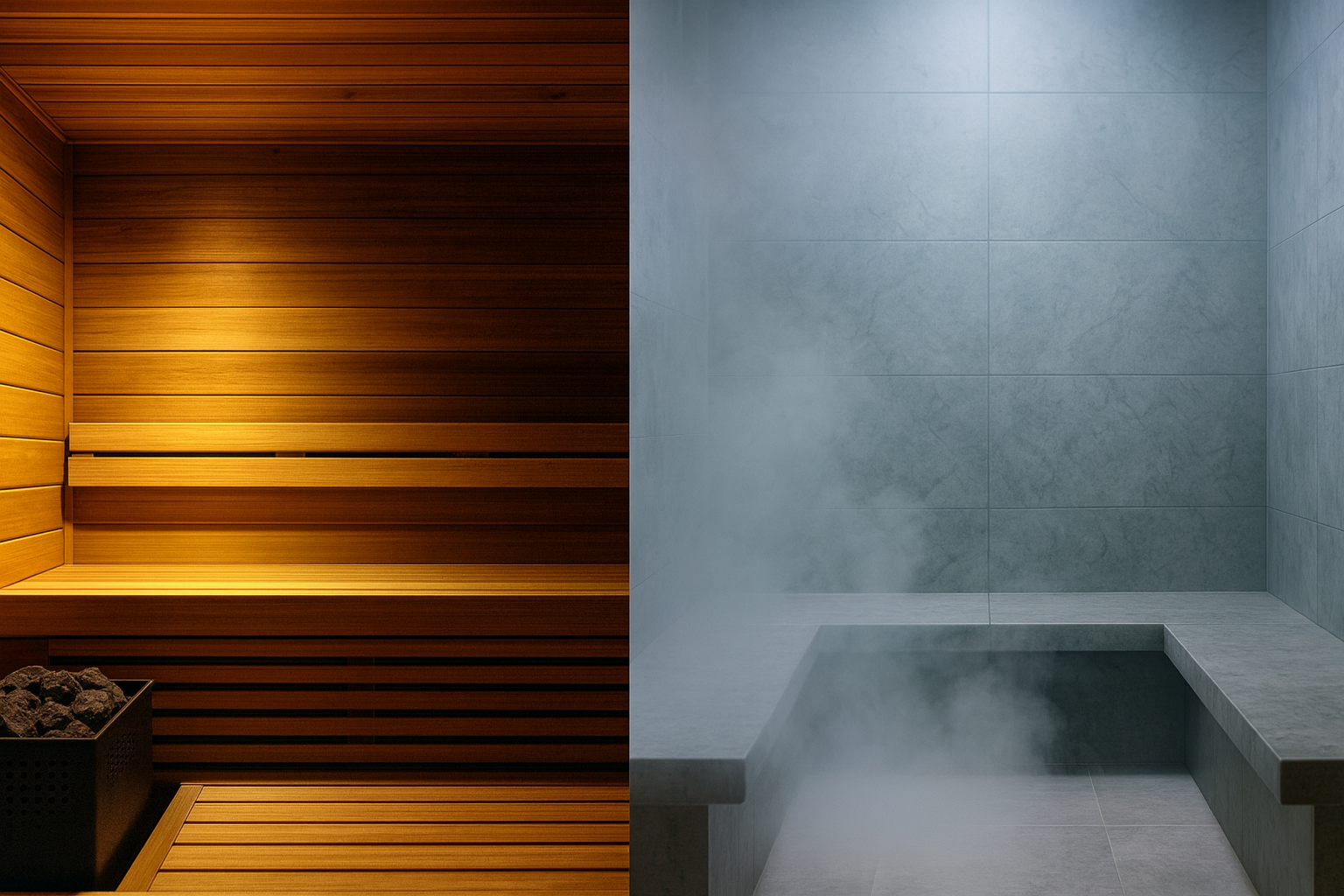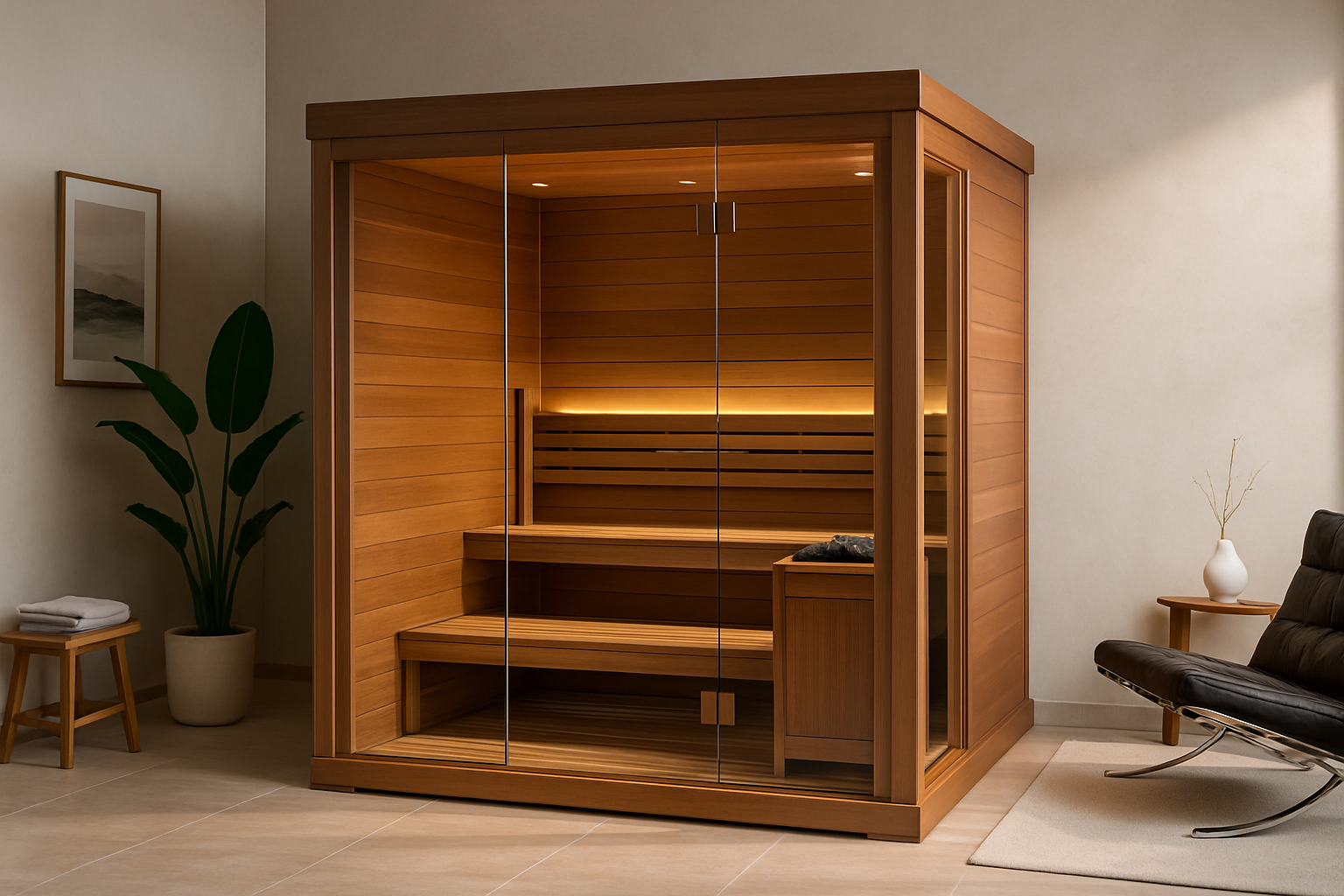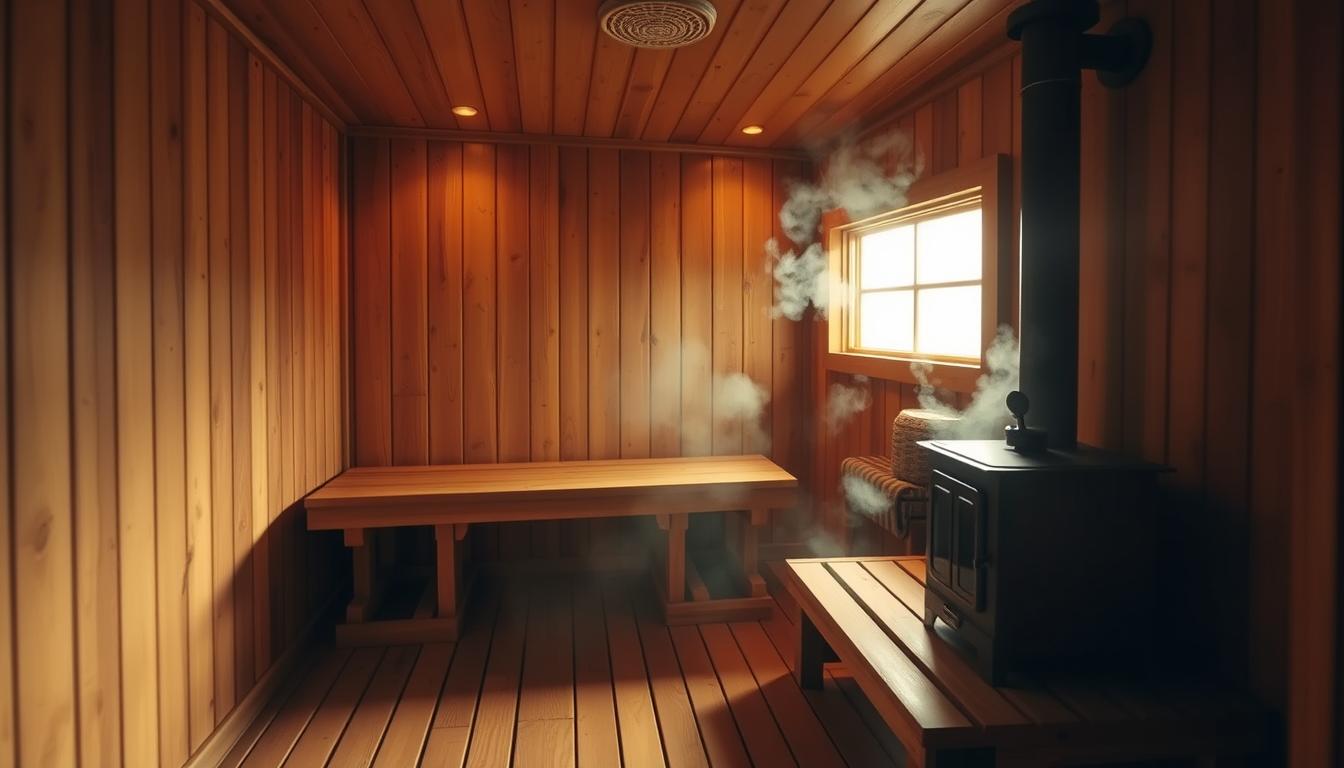
Sauna vs Steam Room: Key Differences, Benefits, and Risks
When choosing between heat therapy options, many people wonder which provides better health benefits and suits their personal needs. Both saunas and steam rooms offer unique wellness experiences through different types of heat exposure.

The main difference lies in their heating methods: saunas use dry heat reaching temperatures up to 195°F, while steam rooms create humid environments with lower temperatures between 110-120°F. This fundamental distinction affects everything from health benefits and therapeutic uses to personal comfort preferences.
Understanding these differences helps people make informed decisions about which option works best for their lifestyle, health goals, and physical conditions. The choice depends on factors like heat tolerance, specific health needs, and desired therapeutic outcomes.
Key Takeaways
- Saunas provide intense dry heat while steam rooms offer humid, lower-temperature environments
- Both options deliver unique health benefits including improved circulation, stress reduction, and muscle recovery
- Personal preferences, health conditions, and specific wellness goals determine which option works best for each individual
Understanding Saunas and Steam Rooms
Saunas use dry heat at temperatures reaching 195°F with minimal humidity, while steam rooms create a humid environment at lower temperatures around 110-120°F. These distinct heat and humidity profiles create completely different wellness experiences for users.
What Is a Sauna?
A sauna is an enclosed room that uses dry heat to create a therapeutic environment. Traditional Finnish saunas reach temperatures between 150°F to 195°F while maintaining very low humidity levels of 5-30%.
The heat source typically consists of a heater with hot rocks. Users can pour water over these rocks to create brief bursts of steam. This process temporarily increases humidity but the environment quickly returns to its dry state.
Sauna construction features:
- Wood materials like cedar, pine, or spruce
- Built-in ventilation systems
- Heated rocks or electric heating elements
- Wooden benches at different heights
The dry heat allows sweat to evaporate quickly from the skin. This natural cooling process helps the body regulate temperature even in the intense heat. Most people can tolerate the high temperatures because of the low moisture content in the air.
What Is a Steam Room
A steam room creates a humid environment using moist heat generated by a steam generator. These rooms maintain temperatures between 110°F to 120°F with 100% humidity levels.
The steam generator boils water to produce continuous steam. This creates a thick, misty atmosphere where visibility becomes limited. The high moisture content prevents sweat from evaporating off the skin.
Steam room construction includes:
- Non-porous materials like tile or glass
- Airtight design to trap moisture
- Steam generator with boiling water
- Sloped ceilings to prevent dripping
The moist heat environment feels less intense than sauna temperatures. However, the body experiences different physiological effects due to the saturated air. Water droplets on the skin come from condensed steam vapor rather than perspiration.
Key Differences Between Sauna and Steam Room
The primary differences between saunas and steam rooms lie in their temperature, humidity, and heat delivery methods.
| Feature | Sauna | Steam Room |
|---|---|---|
| Temperature | 150-195°F | 110-120°F |
| Humidity | 5-30% | 100% |
| Heat Type | Dry heat | Moist heat |
Environmental differences:
- Saunas use dry heat that allows natural sweat evaporation
- Steam rooms create humid environments that prevent sweat evaporation
- Visibility remains clear in saunas but becomes foggy in steam rooms
Construction variations:
- Saunas require wood materials that absorb excess moisture
- Steam rooms need moisture-resistant materials like tile or plastic
- Ventilation systems differ to maintain proper humidity levels
The choice between dry heat and moist heat affects how the body responds. Saunas promote cardiovascular benefits through intense dry heat exposure. Steam rooms excel at respiratory relief through their steam bath environment.
Types of Saunas and Steam Rooms
Different sauna and steam room types use various heating methods and temperature ranges. Traditional saunas rely on dry heat, while infrared models heat the body directly at lower temperatures.
Traditional Sauna
Traditional saunas create dry heat using electric heaters or wood-burning stoves. These Finnish saunas reach temperatures between 180 to 200 degrees Fahrenheit with low humidity levels.
The dry sauna environment allows users to tolerate higher temperatures. Most traditional saunas feature wooden interiors made from cedar or hemlock.
Key Features:
- Temperature: 180-200°F
- Humidity: 10-20%
- Heating method: Electric or wood-burning
- Materials: Cedar or hemlock wood
Home sauna kits make traditional saunas accessible for residential use. These units require proper ventilation and electrical connections for safe operation.
Infrared Sauna
Infrared saunas heat the body directly using light instead of heating the surrounding air. They operate at much lower temperatures between 120 to 150 degrees Fahrenheit.
The infrared light penetrates skin tissue more deeply than traditional heat. This allows users to sweat at comfortable temperatures without extreme heat exposure.
Infrared Sauna Types:
- Near-infrared: Penetrates skin surface
- Mid-infrared: Reaches deeper tissue layers
- Far-infrared: Provides deepest heat penetration
Infrared sauna blankets offer portable options for home use. These wrap-around devices provide infrared heat therapy without requiring dedicated space.
Wood-Burning Sauna
Wood-burning saunas use traditional heating methods with wood-fired stoves. These create authentic Finnish sauna experiences with natural heat distribution.
The wood stove heats sauna stones that radiate dry heat throughout the room. Users can pour water over heated stones to create brief humidity bursts.
Benefits of Wood-Burning:
- Authentic sauna experience
- No electricity required
- Natural heat distribution
- Traditional ambiance
Wood-burning models require chimney installation and regular maintenance. They take longer to heat up compared to electric versions but provide consistent, even heat.
Steam Room Variations
Steam rooms use steam generators to create high humidity environments. They maintain temperatures around 110 to 120 degrees Fahrenheit with nearly 100% humidity.
Common Steam Room Types:
| Type | Temperature | Humidity | Best For |
|---|---|---|---|
| Traditional Steam | 110-120°F | 95-100% | Respiratory health |
| Eucalyptus Steam | 110-120°F | 95-100% | Aromatherapy benefits |
| Herbal Steam | 110-120°F | 95-100% | Skin treatment |
Steam generators require water connections and drainage systems. Regular cleaning prevents bacteria growth in the humid environment.
Home steam rooms need waterproof materials like tile or stone. Proper ventilation prevents moisture damage to surrounding areas.
Health Benefits: Sauna vs Steam Room
Both saunas and steam rooms offer significant health advantages through heat therapy, though each provides unique benefits based on their different heating methods. Saunas excel at cardiovascular support and muscle recovery, while steam rooms particularly benefit respiratory health and skin hydration.
Circulatory and Cardiovascular Benefits
Regular sauna use shows strong links to improved heart health, with studies indicating reduced cardiovascular mortality rates. The dry heat causes blood vessels to dilate, improving blood flow throughout the body.
Steam rooms also enhance circulation but through a different mechanism. The humid heat raises core body temperature more quickly, creating faster cardiovascular responses.
Key cardiovascular improvements include:
- Lower blood pressure from improved vessel function
- Enhanced cardiac function through heat stress adaptation
- Reduced stroke risk from better circulation
- Improved endothelial function in blood vessels
Both environments trigger similar responses to moderate exercise. Heart rate increases while blood pressure initially drops, creating beneficial cardiovascular conditioning over time.
Respiratory and Immune Health
Steam rooms provide superior respiratory benefits due to their high humidity levels. The moist air helps dilate nasal passages and relieves sinus congestion effectively.
People with asthma often find steam rooms more comfortable than saunas. The humid environment can ease breathing difficulties and reduce respiratory irritation.
Saunas may also benefit lung function, particularly for those with chronic bronchitis or hay fever. However, the dry heat can sometimes irritate sensitive airways.
Both environments support immune function through heat stress. This process strengthens the body's natural defense mechanisms and may reduce upper respiratory infections.
Muscle Recovery and Soreness
Heat therapy from both saunas and steam rooms accelerates muscle recovery after exercise. Increased blood flow delivers oxygen and nutrients to tired muscles while removing waste products.
Saunas particularly excel at reducing muscle soreness. The dry heat penetrates deeply into tissues, promoting relaxation and flexibility in tight muscles.
Steam rooms offer gentler muscle recovery benefits. The moist heat helps reduce joint pain and stiffness, making movement more comfortable.
Recovery benefits include:
- Faster healing of minor muscle strains
- Reduced inflammation in sore areas
- Improved joint mobility and flexibility
- Enhanced protein synthesis for muscle repair
Both options work best when users stay properly hydrated before, during, and after sessions.
Skin and Wellness Effects
Steam rooms provide superior skin health benefits through their high humidity. The moist environment helps hydrate skin naturally and may improve conditions like dry skin or eczema.
Saunas promote detoxification through increased sweating. This process helps remove toxins from the body and may boost collagen production in the skin.
Both environments support mental health through relaxation and stress reduction. The heat triggers endorphin release, which improves mood and reduces anxiety levels.
Wellness benefits include:
- Better sleep quality from muscle relaxation
- Reduced stress hormone levels
- Improved skin appearance and texture
- Enhanced overall sense of well-being
Regular use of either option can contribute to better mental health outcomes and improved quality of life.
Therapeutic Uses and Specific Health Conditions

Both saunas and steam rooms offer targeted relief for specific medical conditions, with heat therapy providing measurable benefits for joint pain, chronic conditions, and mental health challenges. The humid environment of steam rooms particularly helps respiratory issues, while dry sauna heat penetrates deeper into muscle tissue.
Arthritis and Rheumatic Conditions
Heat therapy from both saunas and steam rooms helps people with arthritis by increasing blood flow to joints and reducing stiffness. The warming effect makes joints more flexible before physical activity.
Key benefits for arthritis include:
- Reduced morning joint stiffness
- Improved range of motion
- Better blood circulation to affected areas
- Temporary pain relief
Steam rooms work well for rheumatoid arthritis because the moist heat penetrates joints more gently. The humid air feels less harsh on sensitive skin and inflamed joints.
Saunas provide deeper heat penetration that reaches muscle tissue around joints. This helps reduce muscle tension that often makes arthritis pain worse.
People with arthritis should start with shorter sessions of 10-15 minutes. They should exit immediately if joints feel more swollen or painful during use.
Benefits for Fibromyalgia and Chronic Pain
Fibromyalgia patients often find relief from both heat therapy options, though individual responses vary significantly. Heat helps reduce delayed-onset muscle soreness and chronic muscle tension.
Steam rooms offer specific advantages:
- Gentler heat that doesn't overwhelm sensitive nervous systems
- Moist air that feels soothing on tender skin
- Lower temperatures that allow longer sessions
Saunas provide different benefits:
- Deeper muscle penetration for severe pain
- Higher temperatures that may trigger endorphin release
- Dry heat that some find more comfortable
Research shows moist heat works more quickly than dry heat for muscle recovery. This makes steam rooms potentially better for fibromyalgia flare-ups.
Chronic pain sufferers should start with very short sessions. They should monitor their symptoms carefully and stop if pain increases during or after use.
Impacts on Stress and Mental Well-Being
Both environments create natural stress relief through heat exposure and forced relaxation time. Heat therapy may help reduce cortisol levels while promoting the release of feel-good hormones.
Mental health benefits include:
- Reduced anxiety and stress levels
- Improved sleep quality
- Enhanced mood and relaxation
- Forced break from daily stressors
Steam rooms create a meditative atmosphere with their quiet, misty environment. The enclosed space naturally encourages deep breathing and mindfulness.
Saunas offer a different type of mental reset through intense heat exposure. Some people find the challenge of tolerating high temperatures mentally strengthening.
Regular sauna use may lower dementia risk in some populations, though more research is needed. Both options provide valuable time away from screens and daily pressures.
People with severe anxiety should start gradually. The enclosed spaces and heat can initially feel overwhelming for some individuals.
Personalization and Practical Use

Individual preferences, health goals, and daily routines determine which heat therapy works best. Athletes often prefer saunas for muscle recovery, while people with respiratory issues may benefit more from steam rooms' moist environment.
Preferences and Lifestyle Considerations
Athletes typically choose saunas after workouts because the dry heat penetrates muscles more effectively. The high temperatures help reduce muscle soreness and speed recovery time.
People with breathing problems often prefer steam rooms. The moist air helps clear sinuses and ease congestion naturally.
Key factors to consider:
- Schedule flexibility - Saunas require 15-20 minutes, steam rooms need 10-15 minutes
- Skin sensitivity - Dry skin benefits from steam room humidity
- Heat tolerance - Some people handle dry heat better than humid conditions
- Space availability - Home installations vary in size requirements
Busy professionals may find steam rooms more convenient due to shorter session times. The humid environment also provides quick skin hydration benefits.
Personal comfort levels with different temperatures matter significantly. Saunas reach 150°F to 195°F while steam rooms stay cooler at 110°F to 120°F.
Guidelines for Safe Use
Both saunas and steam rooms require proper preparation and timing. Staying hydrated prevents dehydration, the most common risk during heat therapy sessions.
Before entering:
- Drink 16-20 ounces of water
- Shower to remove oils and lotions
- Avoid alcohol completely
- Eat light meals only
During sessions:
- Start with 8-10 minutes for beginners
- Listen to your body's signals
- Exit immediately if feeling dizzy
- Sit on clean towels for hygiene
Time limits by experience:
- Beginners: 8-10 minutes
- Regular users: 15-20 minutes
- Athletes: Up to 20 minutes maximum
People with heart conditions should consult doctors before use. Pregnant women should avoid both saunas and steam rooms without medical approval.
Hydration and Aftercare
Proper hydration starts before entering and continues after leaving. The body loses significant fluids through sweating, regardless of the heat type chosen.
Hydration protocol:
- Pre-session: 16-20 ounces of water
- Post-session: 24-32 ounces within 2 hours
- Athletes may need electrolyte replacement drinks
Core body temperature rises during both therapies. A cool shower immediately after helps normalize body temperature safely.
Post-session routine:
- Cool shower for 2-3 minutes
- Hydrate with water or herbal tea
- Rest for 20-30 minutes before activities
- Avoid strenuous exercise for 1 hour
Adding eucalyptus oil to steam rooms enhances respiratory benefits. The essential oil helps open airways and provides aromatherapy effects.
Some people experience continued sweating for 15-30 minutes after sessions. This is normal but requires ongoing fluid replacement to maintain proper hydration levels.
Choosing the Right Option for Your Needs
The decision between a sauna and steam room depends on specific health priorities, installation requirements, and budget considerations. Personal preferences for dry versus moist heat also play a key role in making the best choice.
Assessing Individual Health Goals
Different health conditions respond better to specific heat therapy types. People with respiratory issues like congestion or sinus problems benefit more from steam rooms' moist heat for respiratory relief.
Heart Health Priorities Those focused on cardiovascular wellness should consider saunas. Research shows frequent sauna use cuts heart disease risk by 50% compared to occasional use.
Skin and Breathing Concerns Steam rooms work better for immediate sinus relief and skin hydration. The high humidity opens airways quickly and adds moisture to dry skin.
Muscle Recovery Needs Both options help with muscle soreness and joint pain. Athletes often prefer saunas for post-workout recovery, while people with arthritis may find steam's penetrating heat more comfortable.
Heat Tolerance Levels Saunas reach 176-212°F with low humidity. Steam rooms stay cooler at 104-122°F but feel more intense due to 100% humidity levels.
Home Installation and Accessibility
Space requirements differ significantly between these two options. Home saunas need proper ventilation and electrical connections, while steam rooms require specialized plumbing and waterproofing.
Installation Complexity Steam rooms need steam generators, waterproof surfaces, and drainage systems. This makes installation more complex than most home saunas, which mainly require electrical work.
Space Considerations
| Feature | Sauna | Steam Room |
|---|---|---|
| Minimum Size | 4x4 feet | 3x3 feet |
| Ceiling Height | 7+ feet | 7+ feet |
| Ventilation | Standard | Specialized |
| Waterproofing | Minimal | Complete |
Maintenance Access Steam generators require regular cleaning and descaling. They also need accessible placement for repairs and part replacement.
Building Code Requirements Both options must meet local building codes. Steam rooms often face stricter requirements due to moisture and electrical safety concerns.
Cost Factors and Maintenance
Initial costs vary widely based on size, materials, and installation complexity. Operating expenses also differ due to energy usage and maintenance needs.
Upfront Investment Home saunas typically cost $3,000-$15,000 installed. Steam rooms range from $8,000-$25,000 due to plumbing and waterproofing requirements.
Operating Costs Saunas use 6-8 kW of electricity per session. Steam generators consume 9-12 kW but heat up faster, potentially using similar total energy.
Maintenance Requirements Steam rooms need more frequent cleaning due to moisture buildup. The steam generator requires descaling every 3-6 months depending on water hardness.
Long-term Durability Properly built saunas last 15-20 years with minimal maintenance. Steam rooms may need generator replacement after 10-15 years of regular use.
Repair Accessibility Sauna repairs typically involve simple electrical or wood issues. Steam generator problems often require professional service calls and specialized parts.
Frequently Asked Questions
Both saunas and steam rooms offer distinct health benefits, from cardiovascular improvements to enhanced recovery. The choice between dry heat and humid heat affects everything from weight loss to skin health.
What are the health benefits of using a sauna compared to a steam room?
Saunas provide cardiovascular health benefits that may reduce the risk of dying from heart disease. The dry heat improves blood circulation and helps with muscle flexibility.
Steam rooms offer similar circulation benefits but excel at respiratory support. The humid environment helps people with breathing issues like asthma and chronic bronchitis.
Both options provide stress reduction and pain relief through improved blood flow. They also support natural detoxification through sweating.
Can utilizing a sauna or steam room after a workout improve recovery?
Heat therapy supports muscle recovery by increasing blood flow to worked muscles. This enhanced circulation helps reduce muscle soreness and stiffness after exercise.
Sauna use after workouts can improve joint mobility and ease muscle tension. The heat helps muscles relax and promotes faster healing.
Both options help remove metabolic waste through sweating. This natural detoxification process can speed up recovery time between training sessions.
Which is more effective for weight loss, a sauna or a steam room?
Neither saunas nor steam rooms directly burn significant calories for weight loss. The weight lost during sessions comes primarily from water through sweating.
Heat therapy may boost calorie burn equivalent to up to 600 calories per half hour. However, more research is needed to confirm these effects.
Any weight loss from sauna or steam room use returns once the body rehydrates. These tools work best as part of a complete fitness and nutrition plan.
Which is better for skin health, a sauna or a steam room?
Steam rooms benefit people with dry skin conditions due to the high humidity levels. The moist heat can help hydrate and soften skin naturally.
Saunas may help people with psoriasis through controlled heat therapy. Infrared saunas can boost collagen production in the skin.
Both options promote sweating, which helps clear pores of toxins and impurities. However, people with eczema should consult a doctor before using either option.
Should I use the sauna or the steam room first during my spa visit?
Most experts recommend starting with the steam room when using both on the same day. The lower temperature helps the body adjust gradually to heat therapy.
Moving from steam room to sauna allows for a progression from humid heat to dry heat. This sequence may feel more comfortable for most people.
Some prefer the opposite order based on personal tolerance. The key is listening to the body and staying hydrated throughout both sessions.
Is it safe to use both a sauna and a steam room on the same day, and if so, how should they be alternated?
Using both on the same day is generally safe for healthy adults. Experts suggest being mindful of total sweating to avoid overdoing it.
Limit each session to 15-20 minutes maximum with breaks between uses. Allow the body to cool down and rehydrate between sessions.
Drink at least two glasses of water after each session. Take a cool shower between uses to help regulate body temperature and prevent overheating.







Leave a comment
This site is protected by hCaptcha and the hCaptcha Privacy Policy and Terms of Service apply.